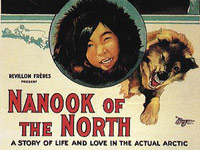|
text k videu
"Nanook of the North" (also known as A Story Of Life and Love In the Actual Arctic) is a 1922 silent documentary film by Robert J. Flaherty. In the tradition of what would later be called salvage ethnography, Flaherty captured the struggles of the Inuk Nanook and his family in the Canadian Arctic. The film is considered the first feature-length documentary. In 1989, this film was one of the first 25 films to be selected for preservation in the United States National Film Registry by the Library of Congress as being "culturally, historically, or aesthetically significant.
The documentary follows the lives of an Inuit, Nanook, and his family as they travel, search for food, and trade in northern Quebec, Canada. Nanook, his wife, Nyla, and their baby, Cunayou, are introduced as fearless heroes who endure rigors "no other race" could survive.
Robert Joseph Flaherty, F.R.G.S. (/ˈflæhɜrtiː/) (February 16, 1884 -- July 23, 1951) was an American filmmaker who directed and produced the first commercially successful feature length documentary film, Nanook of the North (1922). The film made his reputation and nothing in his later life fully equaled its success, although he continued the development of this new genre of docufiction.
In 1913, on his expedition to prospect the Belcher Islands, his boss, Sir William Mackenzie, suggested that he take a motion picture camera along. Flaherty brought with him a Bell and Howell hand cranked motion picture camera. He was particularly intrigued by the life of the Inuit people, and spent so much time filming them that he had begun to neglect his real work.
When Flaherty returned to Toronto with 30,000 feet of film, the nitrate film stock was ignited in a fire started from his cigarette, in his editing room. His film was destroyed and he received burns on his hands. Although his editing print was saved and shown several times, Flaherty wasn't satisfied with the results. "It was utterly inept, simply a scene of this or that, no relation, no thread of story or continuity whatever, and it must have bored the audience to distraction. Certainly it bored me."
Flaherty was determined to make a new film, one following a life of a typical Inuit and his family. In 1920, Flaherty secured funds from Revillon Frères, a French fur trade company to shoot what was to become Nanook of the North. On the 15th of August, 1920 Flaherty arrived in Port Harrison, Quebec to shoot his film. With him he took two Akeley motion-picture cameras which the Inuit referred to as "the aggie". Flaherty also brought full developing, printing and projection equipment to show the Inuit his film, while he was still in the process of filming. Flaherty lived in an attached cabin to the Revillon Frères trading post.
In making Nanook, Flaherty cast various locals in parts in the film, in the way that one would cast actors in a work of fiction. With the aim of showing traditional Inuit life, Flaherty also staged some scenes, including the ending, where Allakariallak (who acts the part of Nanook) and his screen family were supposedly at risk of dying if they could not find or build shelter quickly enough.
The half-igloo had been built beforehand, with a side cut away for light so that Flaherty's camera could get a good shot. Additionally, Flaherty insisted that the Inuit not use rifles to hunt, though their use had by that time become common. He also pretended at one point that he could not hear the hunters' pleas for help, instead continuing to film their struggle and putting them in greater danger.
Melanie McGrath, a writer, writes that, while living in Northern Quebec for the year of filming Nanook, Flaherty had an affair with his lead actress, the young Inuit woman who played Nanook's wife. A few months after he left, she gave birth to his son, Josephie, whom he never acknowledged.
Resources: wikipedia.org, archive.org
New soundtrack and dubbing: Cinemateca
Music: Kevin MacLeod (incompetch.com) licensed under Creative Commons licence: Attribution 3.0 Unported (CC BY 3.0).
|
x
 Dokumentární film
Dokumentární film amerického režiséra Roberta J. Flahertyho z roku 1922. Film byl natočen v souladu s principy takzvané salvage anthropology (záchranné antropologie), tedy s cílem zdokumentovat a pro budoucnost zachovat kultury, kterým měl hrozil zánik. Flahertyho film měl zachycovat život Inuita Nanooka a jeho rodiny, jenž žily v arktické části Kanady. Nanook of the North je považovaný za první dlouhometrážní dokumentární film.
V originále se nazývá Nanook of the North. Zaznamenaný rok života mezi Eskymáky, Inuity. Popisuje jak obchodují, loví, rybaří, a cestují... nedotčení moderní civilizací.
|
